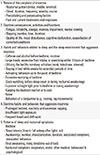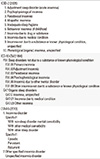Abstract
Insomnia is the most common sleep problem affecting nearly one-third of the population as either a primary or comorbid condition. Insomnia has been defined as both a symptom and a disorder, and is characterized as sleep that is chronically unrestorative or poor in quality often due to difficulty in initiating sleep, in maintaining sleep, or with waking up too early. Insomnia results in some form of daytime impairment in the patient's normal activites. Although the exact pathophysiology of insomnia is poorly understood, it is often believed to arise from a state of hyperarousal in multiple neurophysiological and/or psychological systems. Population-based studies suggest that while about one-third of the general population complains of sleep disturbance, only 10-15 percent has associated symptoms of daytime functional impairment, and even fewer, only 6-10 percent have impairments sufficient for the diagnostic criteria of insomnia. The cornerstone of the insomnia evaluation and diagnosis is a comprehensive history obtained by the clinical interview with patient and/or family. Additional assessment tools, such as sleep diary or log, various questionnaires, actigraphy, and multichannel polysomnography (PSG) have been used as an aid to diagnosis, although many are limited in their validation. Insomnia causes a significant burden of medical, psychiatric, societal consequences on the individual and societal level. Clinicians in either primary settings or specialized clinics should have knowledge to manage insomnia with confidence.
Figures and Tables
Table 3
Precipitating and perpetuating factors of insomnia

Ref. 1 with permission from American Psychiatric Publishing.
Table 4
Sleep/wake history in the evaluation of insomnia

Ref. 12 with permission from American Psychiatric Association.
References
1. American Psychiatric Association. Diagnostic and Statistical Manual of Mental Disorders. 5th ed. Washington DC: American Psychiatric Publishing;2013. p. 361–422.
2. NIH State of the Science Conference statement on Manifestations and Management of Chronic Insomnia in Adults statement. J Clin Sleep Med. 2005; 1:412–421.
4. Lee S, Cheong YS, Park EW, Choi EY, Yoo HK, Kang KH, et al. Prevalence of sleep disorder and associated factors in family practice. Korean J Fam Med. 2010; 31:837–844.

5. Cho YW, Shin WC, Yun CH, Hong SB, Kim J, Earley CJ. Epidemiology of insomnia in korean adults: prevalence and associated factors. J Clin Neurol. 2009; 5:20–23.

6. Mai E, Buysse DJ. Insomnia: Prevalence, Impact, Pathogenesis, Differential Diagnosis, and Evaluation. Sleep Med Clin. 2008; 3:167–174.

7. Green MJ, Espie CA, Hunt K, Benzeval M. The longitudinal course of insomnia symptoms: inequalities by sex and occupational class among two different age cohorts followed for 20 years in the west of Scotland. Sleep. 2012; 35:815–823.

8. Morin CM, Belanger L, LeBlanc M, Ivers H, Savard J, Espie CA, et al. The natural history of insomnia: a population-based 3-year longitudinal study. Arch Intern Med. 2009; 169:447–453.
9. Buysse DJ, Angst J, Gamma A, Ajdacic V, Eich D, Rossler W. Prevalence, course, and comorbidity of insomnia and depression in young adults. Sleep. 2008; 31:473–480.

10. LeBlanc M, Beaulieu-Bonneau S, Merette C, Savard J, Ivers H, Morin CM. Psychological and health-related quality of life factors associated with insomnia in a population-based sample. J Psychosom Res. 2007; 63:157–166.

11. Zhang J, Lam SP, Li SX, Li AM, Lai KY, Wing YK. Longitudinal course and outcome of chronic insomnia in Hong Kong Chinese children: a 5-year follow-up study of a community-based cohort. Sleep. 2011; 34:1395–1402.

12. Doghramji K, Grewal R, Markov D. Evaluation and management of insomnia in the psychiatric setting. Focus. 2009; 7:441–454.

13. Riemann D, Spiegelhalder K, Espie C, Pollmacher T, Leger D, Bassetti C, et al. Chronic insomnia: clinical and research challenges--an agenda. Pharmacopsychiatry. 2011; 44:1–14.
14. Riemann D, Spiegelhalder K, Feige B, Voderholzer U, Berger M, Perlis M, et al. The hyperarousal model of insomnia: a review of the concept and its evidence. Sleep Med Rev. 2010; 14:19–31.

15. Bonnet MH, Arand DL. Hyperarousal and insomnia: state of the science. Sleep Med Rev. 2010; 14:9–15.

16. Schutte-Rodin S, Broch L, Buysse D, Dorsey C, Sateia M. Clinical guideline for the evaluation and management of chronic insomnia in adults. J Clin Sleep Med. 2008; 4:487–504.

17. Omachi TA. Measures of sleep in rheumatologic diseases: Epworth Sleepiness Scale (ESS), Functional Outcome of Sleep Questionnaire (FOSQ), Insomnia Severity Index (ISI), and Pittsburgh Sleep Quality Index (PSQI). Arthritis Care Res (Hoboken). 2011; 63:Suppl 11. S287–S296.

18. Benca R, Lichstein KL. Sleep disorders measures. In : Rush AJ, First MB, Blacker D, editors. Handbook of psychiatric measures. 2nd ed. Washington, DC: American Psychiatric Publishing;2008. p. 649–666.
19. Morin CM, Vallieres A, Ivers H. Dysfunctional beliefs and attitudes about sleep (DBAS): validation of a brief version (DBAS-16). Sleep. 2007; 30:1547–1554.

20. Morgenthaler T, Alessi C, Friedman L, Owens J, Kapur V, Boehlecke B, et al. Practice parameters for the use of actigraphy in the assessment of sleep and sleep disorders: an update for 2007. Sleep. 2007; 30:519–529.

21. Seo HJ, Hong SC. Actigraphy in sleep disorders. Korean J Psychopharmacol. 2010; 21:183–194.




 PDF
PDF ePub
ePub Citation
Citation Print
Print





 XML Download
XML Download